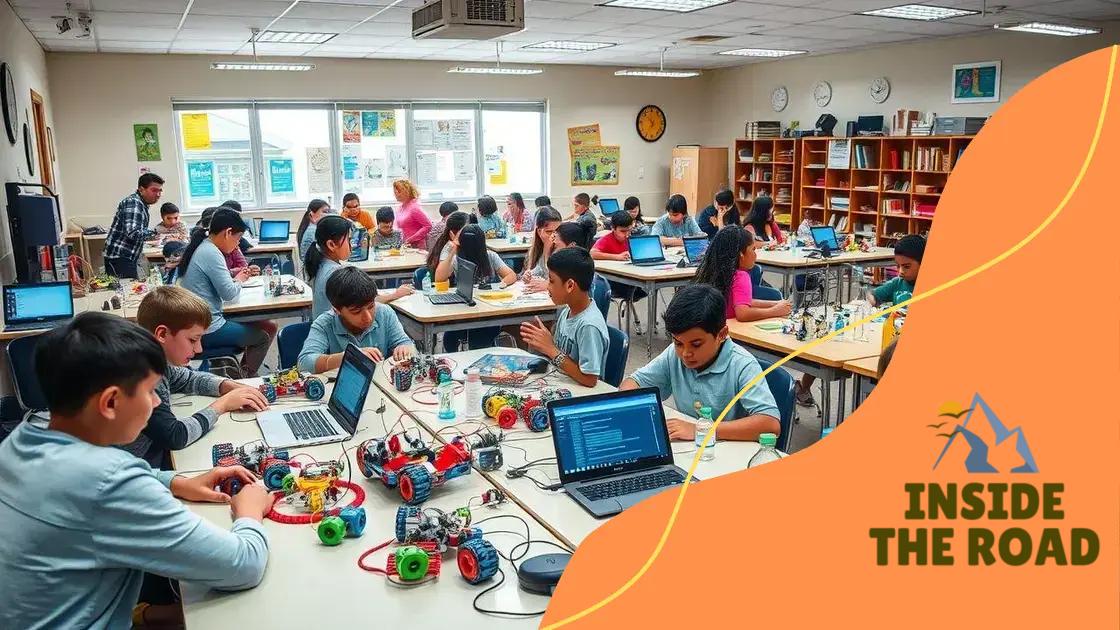The evolution of STEM education in primary schools

The evolution of STEM education in primary schools focuses on integrating technology, hands-on learning, and interdisciplinary approaches to prepare students for future challenges and enhance engagement in critical subjects.
In today’s rapidly changing world, the evolution of STEM education in primary schools plays a crucial role in preparing students for future challenges. Have you ever wondered how these subjects connect and engage young learners? Let’s delve into the journey of making STEM vibrant and meaningful for children.
Understanding the importance of STEM education
Understanding the importance of STEM education is crucial in today’s world. It equips students with essential skills that prepare them for future challenges. Schools worldwide are recognizing that a strong foundation in science, technology, engineering, and mathematics fosters critical thinking and innovation.
Benefits of STEM Education
STEM education offers numerous benefits to students. Engaging with these subjects encourages creative problem solving and analytical thinking. Through hands-on activities, students learn how to approach tasks systematically, which is valuable in any career.
- Enhances critical thinking skills.
- Encourages teamwork and collaboration.
- Builds resilience through problem-solving.
- Prepares students for STEM careers.
The integration of technology in the classroom further amplifies the benefits of STEM education. Digital tools and resources allow students to explore concepts more deeply and interactively. With technology, lessons become more engaging, catering to different learning styles.
Real-World Applications
Moreover, STEM education connects classroom learning to real-world applications. Students can see how mathematics informs engineering designs or how science principles affect technology development. This relevance is motivating for young learners, making them eager to explore these fields.
Schools are increasingly emphasizing project-based learning. This approach enables students to apply their knowledge to practical challenges, reinforcing their learning through experience. As they collaborate on projects, they develop communication skills, critical for their future success.
Engaging Students in STEM
Educators play a pivotal role in making STEM education captivating. Innovative teaching strategies can ignite curiosity and passion among students. Incorporating games, experiments, and visuals, educators can create an immersive learning environment. As they experiment and explore, students become active participants in their education.
- Utilizing interactive technology tools.
- Incorporating hands-on experiments.
- Promoting collaborative group work.
- Connecting lessons to real-world scenarios.
By prioritizing STEM education, primary schools are not just teaching facts; they are nurturing the innovators of tomorrow. Educators must continue adapting their methods to meet the changing needs of students, ensuring they remain engaged and intrigued by the world around them.
Key developments in STEM curriculum
The key developments in STEM curriculum have transformed how students learn about science, technology, engineering, and mathematics. These changes focus on making education more engaging and relevant, preparing students for the demands of the 21st century.
Integrating Technology
One significant development is the incorporation of technology into the curriculum. Schools now use interactive tools and resources to enhance lessons. Digital platforms allow students to explore concepts in a hands-on manner, fostering deeper understanding and retention.
- Online simulations and experiments
- Virtual labs for scientific exploration
- Software for coding and robotics
- Access to global resources and information
Furthermore, project-based learning has emerged as a vital teaching approach within the STEM curriculum. By working on real-world challenges, students apply their knowledge in practical situations. This method not only boosts motivation but also promotes critical thinking skills, as students must analyze problems and devise solutions.
Interdisciplinary Learning
The trend of interdisciplinary learning is also significant. Integrating subjects allows students to see connections between different fields. For instance, combining math with science helps students understand the relevance of calculations in conducting experiments.
Additionally, educators are now focusing on soft skills alongside technical skills, acknowledging their importance in future workplaces. Skills like teamwork, communication, and adaptability are woven into lessons, ensuring that students are well-rounded.
Incorporating Inclusive Practices
Another key development is the emphasis on inclusivity in STEM education. Programs are designed to be accessible to all students, regardless of background or ability. Educators are trained to recognize diverse learning needs, ensuring that every child can thrive in STEM subjects.
- Engaging underrepresented groups in STEM
- Personalized learning plans for students
- Use of varied teaching methods to cater to different learners
- Support systems for struggling students
By adapting curricula to be more inclusive, schools create a nurturing environment that encourages participation and curiosity among all students. As a result, students feel empowered to explore STEM fields, paving the way for the next generation of innovators.
Innovative teaching methods in primary schools

Innovative teaching methods in primary schools are reshaping how students engage with their education. These approaches focus on making learning interactive and relevant, helping young learners develop a love for STEM subjects.
Hands-On Learning
One highly effective method is hands-on learning. By allowing students to experiment and explore, teachers create a dynamic learning environment. For example, using building blocks in math lessons helps students visualize concepts.
- Experimenting with science projects.
- Utilizing art in engineering tasks.
- Incorporating games into mathematics.
- Applying real-world problems in discussions.
Additionally, project-based learning encourages teamwork and critical thinking. When students work together on projects, they learn to communicate effectively and solve problems creatively. This method nurtures collaboration and gives students a sense of ownership in their learning.
Use of Technology
The integration of technology in classrooms is another innovative direction. With access to tablets and computers, students can engage with learning materials in ways that were once unimaginable. They can take virtual field trips, participate in online simulations, and collaborate with peers across the globe.
Teachers can utilize educational apps to customize learning experiences. This allows for personalized learning paths that cater to different student needs. For example, students can practice math skills at their own pace using interactive software.
Flipped Classroom Model
Another method gaining popularity is the flipped classroom model. Here, students learn new content at home through videos and online assignments. Classroom time is then reserved for discussions, hands-on activities, and deeper exploration of the subject matter.
This shift encourages students to take more responsibility for their learning, fostering independence and critical thinking. It allows teachers to spend time addressing individual questions and offering support where necessary.
In summary, these innovative teaching methods create exciting and effective learning environments in primary schools. They help students build essential skills for the future while fostering a genuine interest in STEM education.
Impact of technology on STEM learning
The impact of technology on STEM learning is profound and far-reaching. In today’s classrooms, technology serves as a powerful tool that enhances educational experiences and prepares students for a digital future.
Enhanced Engagement
One of the primary benefits of incorporating technology is increased student engagement. Interactive and multimedia resources capture students’ interests far better than traditional methods. For instance, simulations and educational games make learning more fun and relatable.
- Using virtual labs for science experiments.
- Implementing coding games for programming skills.
- Utilizing animation and videos to explain complex concepts.
- Encouraging students to create digital presentations.
Furthermore, technology provides instant feedback. Educational software often allows students to see their progress in real-time, helping them understand their strengths and areas for improvement. This timely feedback can motivate students to take charge of their learning journeys.
Collaboration and Communication
Technology also fosters better collaboration among students. Online platforms enable them to work in teams, share ideas, and communicate seamlessly. Whether through Google Classroom, discussion boards, or project management tools, students can learn to collaborate effectively, a critical skill in modern workplaces.
Moreover, technology breaks down geographical barriers. Students can connect with experts and peers worldwide, broadening their perspectives. This global collaboration enriches the learning process, allowing students to tackle real-world issues with diverse viewpoints.
Personalized Learning Experiences
Another significant advantage is the ability to personalize learning experiences. With adaptive learning technologies, educators can tailor lessons to meet each student’s unique needs. Students progress at their own pace, ensuring mastery of subjects before moving on to more complex topics.
- Using apps that adapt to learning speeds.
- Creating customized study plans based on assessments.
- Offering a variety of resources for different learning styles.
- Tracking individual progress to adjust lessons accordingly.
The integration of technology in STEM education not only enhances learning outcomes but also prepares students for future challenges. As they become comfortable with various tools and platforms, students gain the confidence and skills they will need in a technology-driven world.
Future trends in STEM education
Future trends in STEM education are set to reshape how students interact with these critical subjects. As technology evolves, classrooms are changing to meet the needs of modern learners. Understanding these trends can help educators prepare students for the challenges of tomorrow.
Emphasis on Coding and Computational Thinking
One of the most significant trends is the growing emphasis on coding and computational thinking. Schools are beginning to integrate programming into the curriculum at an early age. Learning to code not only teaches students how to create technology but also enhances problem-solving skills.
- Introducing coding languages like Scratch for younger students.
- Implementing robotics programs to teach real-world applications.
- Offering after-school coding clubs to sustain interest.
- Bringing in guest speakers from tech industries.
As students become more familiar with coding, they gain valuable skills that are in high demand in many fields.
Increased Use of Artificial Intelligence
Another emerging trend is the incorporation of artificial intelligence (AI) in educational tools. AI can help personalize learning experiences for students, making lessons more adaptive to individual needs. Programs that utilize AI can assess a student’s strengths and weaknesses, providing customized resources to help them succeed.
This technology allows teachers to focus more on guiding students rather than just delivering content. Additionally, exposing students to AI concepts prepares them for careers in this rapidly growing field.
Interdisciplinary Learning Approaches
Interdisciplinary learning is also gaining traction. This approach combines subjects such as science, technology, engineering, and math into cohesive learning experiences. By relating concepts from different subjects, students can see the real-world applications of their studies.
For instance, a project might require students to use math and science to solve engineering problems, encouraging them to draw connections across disciplines. This type of learning fosters holistic understanding and critical thinking.
Focus on Real-World Problems
Moreover, there is a growing focus on teaching students to address real-world problems. Projects that involve community issues or global challenges engage students on a deeper level. By working on these issues, students learn to apply their knowledge to meaningful contexts.
- Collaborating with local organizations to create solutions.
- Participating in environmental projects to understand climate change.
- Innovating in health tech to address public health issues.
- Utilizing design thinking methods to solve practical problems.
As STEM education continues to evolve, these trends will likely shape the future workforce. By integrating these elements into learning, educators can help students develop the skills needed to thrive in an ever-changing world.
FAQ – Frequently Asked Questions about STEM Education
How is technology changing STEM education?
Technology enhances STEM education by making learning interactive and engaging. Tools like coding apps and virtual labs enrich the learning experience.
What are the benefits of interdisciplinary learning in STEM?
Interdisciplinary learning helps students connect concepts from different subjects, promoting critical thinking and real-world problem-solving skills.
Why is hands-on learning important in STEM?
Hands-on learning allows students to experiment and explore, making abstracts concepts more tangible and fostering a deeper understanding of the material.
What trends are shaping the future of STEM education?
Future trends include a focus on coding, the use of artificial intelligence, and connecting learning to real-world problems, preparing students for their careers.






